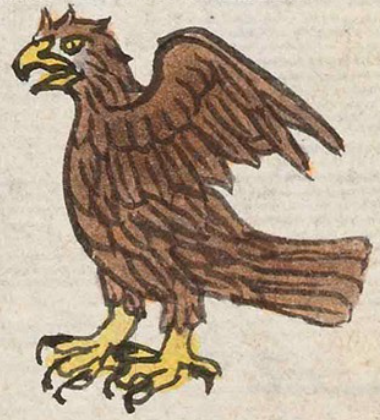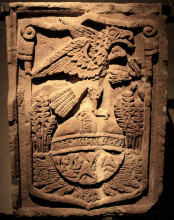cuauhtli (Mdz10v)
This simplex glyph of an eagle (cuauhtli) also represents the place name Cuauhtlan. The eagle is viewed from the side, where it faces to our left, and shows its full body. Its beak is parted somewhat and wings are slightly raised, as though the bird is about to take flight. The eagle has brown feathers, but yellow/gold feet, eye, and beak. The area between the beak and eye is light gray or white. The thick, black claws are especially notable, large compared to the relative size of the beak.
Stephanie Wood
Eagles are prevalent in this corpus of glyphs, somewhat indicative of their importance in the culture. The association with Aztec warriors is not something that necessarily stands out, however. Whether showing the head or the whole body, representations of eagles are fairly naturalistic. The focus is on the bird. We do not see them in flight, which can be a majestic sight in nature; they are simply present. In this corpus, eagle feathers do have some association with war or hunting, as they appear on arrows and on accoutrements that could have a warrior association, such as we see with the cuauhquemitl, which was apparently worn on a person's chest.
Stephanie Wood
c. 1541, or by 1553 at the latest
Stephanie Wood
Joseph Scott and Crytal Boulton-Scott made the SVG.
birds, feathers, ave, aves, pájaro, pájaros, pluma, plumas, animals, animales
cuauhtli. Art historians believe that this early post-contact Franciscan shield was created by an Indigenous artist who crowned the Order's device with a Mexica-style eagle. Museo Cultural de Santo Domingo, Oaxaca. Photograph by Robert Haskett, 29 June 2011.

cuauh(tli), eagle, https://nahuatl.wired-humanities.org/content/cuauhtli
eagle (here, full bird)
el águila
Stephanie Wood
Codex Mendoza folio 10 verso, https://digital.bodleian.ox.ac.uk/objects/2fea788e-2aa2-4f08-b6d9-648c00..., image 31 of 188.
The Bodleian Libraries, University of Oxford, hold the original manuscript, the MS. Arch. Selden. A. 1. This image is published here under the UK Creative Commons, “Attribution-NonCommercial-ShareAlike 3.0 License” (CC-BY-NC-SA 3.0).



